
Though our bodies haven’t changed extensively, mountain bike saddles have. As modern mountain bike frames continue to stretch further between the bottom bracket and the bars in the name of stability, seat tubes have moved forward to keep us from stretching out like sleepy cats. Those steeper seat post angles mean we no longer need cutouts at the back of the saddle to mitigate tire rub, and saddles can be shorter since we’re using less of them in an upright position and want them to disappear when the dropper slams.
If you’re in the market for a new saddle, testing a few from your local bike shop is by far the best way to determine proper saddle fit. While we can share our personal experience with these components, we have no clue how they will feel when you sit on them with your own unique bum. If you live in a rural area, away from major bike shops, borrowing saddles from friends and neighbors can be a good way to gauge your fit.
Here we’ll give you about a dozen saddles we have tested and can recommend as a starting point in your quest for the perfect saddle. After the product recommendations we’ll go over how to choose a saddle so you’ll be armed with plenty of information to pick the best mountain bike saddle.
Mountain Bike Saddles Tested
Here are 12+ of the best MTB saddles Singletracks reviewers have tested over the years. All of the saddles here can be a good choice, though the following stand out.
- Most comfortable for long pedally days: Ergon SMC Core
- Best saddle for e-bikes: SDG Bel-Air V3 Max
- Best value MTB saddle: WTB Volt
- Lightest MTB saddle tested: SQLab 612 Ergowave
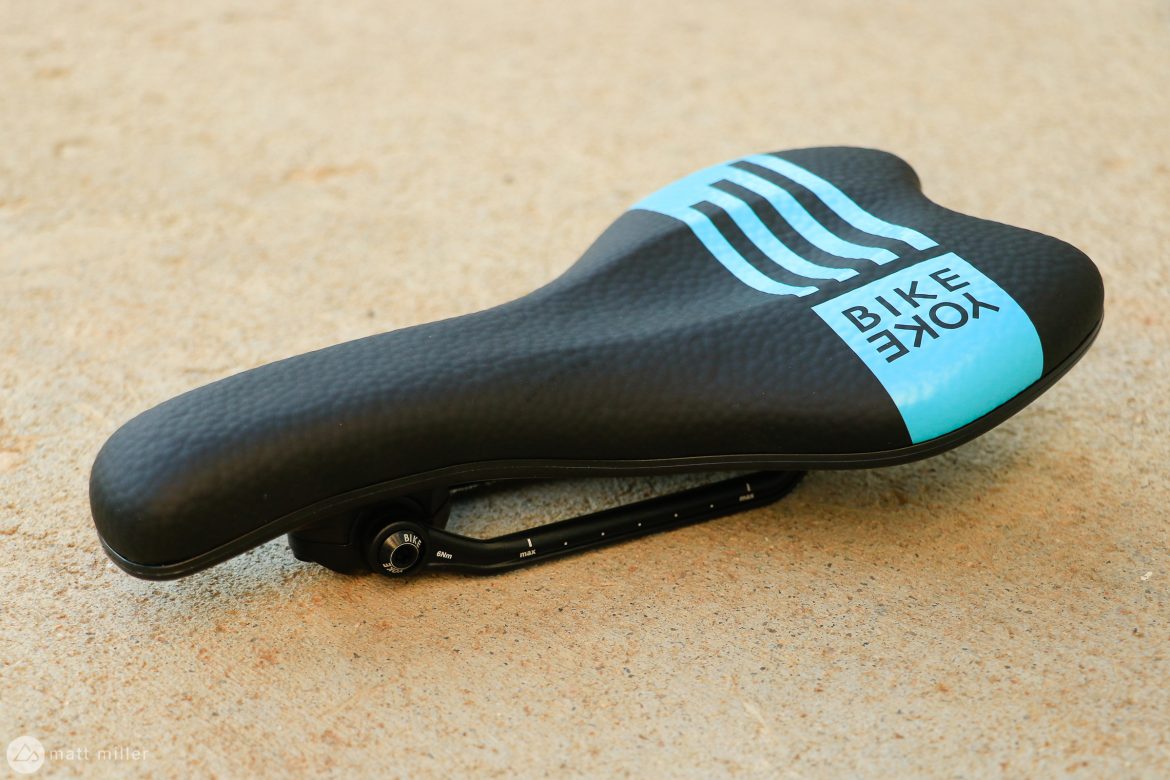
Bike Yoke Sagma
- Price: $140
- Weight: 225g
- Buy from Amazon.
The Bike Yoke Sagma saddle has ovalized aluminum rails with a suspension design that utilizes shock absorbers for a bit of damping technology under the derriere. Buyers can customize the amount of damping by swapping included shock absorbers. Overall the saddle has a shorter length and is available in two widths, 130mm and 142mm.
Read a complete review of the Bike Yoke Sagma saddle.

Ergon SM Pro Men
- Price: $119.95
- Weight: 235g
- Buy from Amazon and other retailers.
The Ergon saddle has taken me the most time to get used to. Mounting the Ergon SM (Saddle Mountain), it’s easy to tell the difference between it and saddles from any other brand. I was in between saddle sizes as Ergon splits their sizes with 9-12cm wide sit bones recommended for a size small and 12-16cm wide sit bones for the size M/L.
The Ergon saddles sit very broad and wide, with a relief channel down the center. The idea with Ergon — and with other saddles — is that the rider’s sit bones should take all of the pressure from the saddle, so that the nerves around your pelvis aren’t pinched, which leads to numbing. It may not be comfortable at first, but the idea is that your sit bones will adjust to the increased pressure on them.
I used the Ergon SM Pro during my time at BC Bike Race, for seven days of XC riding, and I meshed very well with the Ergon saddle. Once I got used to it, it remained comfortable in any pedaling situation.

Ergon SMC Women’s Mountain Bike Saddle
- Price: $79.95
- Weight: 294g
- Buy from REI and other online retailers.
The Ergon SMC women’s mountain bike saddle is designed by women for women. It’s comfortable, does not create pain or numbness, and is reasonably priced. If you’re looking for a cushy, do-all saddle, the SMC Women’s saddle is a great option.
Read our complete review of the Ergon SMC Women’s saddle here.

Ergon SMC Core Saddle
- Weight: 345g
- Price: $150
- Buy from REI.
The Ergon SMC Core saddle features a running-shoe-like foam material along with a dual-shell construction that’s designed to minimize trail vibrations, and in our experience, it delivers. We found it’s both comfortable and durable, even for hardtail riding.
Read our complete Ergon SMC Core saddle review.

Fabric Scoop Radius
- Price: from $44.95 ($105 Race, tested)
- Weight: 250-260g
- Buy at Amazon
The Fabric Scoop Radius has the roundest profile in the rear and the most padding. This means, unlike a saddle like the Ergon SM Pro that is very flat, it is less sit-bone oriented, which Fabric says makes it ideal for upright riding positions. When we’re more upright, the saddle holds the majority of our weight and calls for more padding.
The more a rider leans forward, the more they expose and compress nerves in their pelvis against a saddle, so a flatter profile is better, and weight is distributed against the handlebars more.
I’ve found Fabric’s description of the saddle is spot on. It’s very comfortable, and feels more round and cushy. On the flip side, for XC, or longer rides when I’ve been in the seated position and more forward for climbing, I’ve had some numbness. The Radius is best suited for upright riding, like casual enduro climbing positions.

The Fabric Scoop Shallow is the Radius’ flatter brother, meant for longer pedal days and extended comfort in the saddle. You can see the difference in profile in the image above. The Radius on the left rounds quite a bit more and the Shallow is much flatter. The Shallow saddle better suited to more saddle time, and I experienced less numbness with rides on the Shallow.

Fi’zi:k Gravita Alpaca X5
- Price: $109.99
- Weight: 216 g
- Available at JensonUSA and other online retailers
Why not name a saddle after an adorably furry spitting animal from South America? The Fizik Gravita Alpaca X5 comes in one color, size, and shape. There’s also a Terra Alpaca version, said to be a more all-mountain/enduro focused saddle than the Gravita’s further DH-aligned intentions.
The Gravita Alpaca is flatter still. You might say it’s Netherlands-flat. The cover material looks and feels like the seats in a luxury car, and somehow it has handily endured a number of slides across the trail. The smooth skin is tougher than it looks for sure. Under that layer, the widest points are designed to flex on impact, making for a comfortably cush sensation on rough trails.


The 130mm-wide saddle has a stubby nose, cutting the total length to 251mm. The useable area stays a little wider as you slide forward which allows for additional climbing positions when the trail tilts up. Given this maneuverability, I was able to run the Gravita Alpaca a little further back on the rails and select my position based on the trail’s pitch. If you dig a flat platform to push against, and plenty of places to put your sit-bones on the way uphill, this MTB saddle is worth a try.
Most mountain bike saddles have two separate rails molded into the plastic or fiberglass body at either end. The “S-Alloy” rails on this new model from Fizik are shaped similarly to a large staple, connected at the back side to increase strength and distribution of the load. As a result, I expect this saddle to be less likely to start creaking over time.

Funn Adlib HD Saddle
- Weight: 335g
- Price: $55
- Buy from Amazon.
Priced at only $55, the Funn Adlib HD provides tremendous value and is available in multiple colors. I did not experience any discomfort or any annoying creaking while testing this saddle. Assuming the size and weight is not an issue, it caters to a very wide audience ranging from beginners to pro enduro racers.
Read the complete Funn Adlib HD saddle review.

SDG Bel-Air V3 Saddle
- Price: $89.99 (Lux-Alloy version)
- Weight: 236g
- Buy from Jenson USA and other online retailers
Like others in this saddle roundup, the third generation SDG Bel-Air has been updated to reflect progressive mountain bike geometry with a shorter overall length and the same slight rear rise for support when it’s time to lay down the watts. Designed for comfort with a descent-friendly shape, SDG recommends the Bel-Air MTB saddle for everything from XC to enduro.


The Bel-Air V3 saddle features a hidden cutout and an average amount of padding that most riders should find more than adequate. The base is made of a nylon material that offers great support while still providing a decent amount of flex. At 140mm wide, the saddle should fit most riders’ sit bones while in a neutral mountain biking position. That is, it might not be the most comfortable for pedaling in an aggressive XC racing position or for sitting completely upright like on a cruiser bike, but for most applications and for many riders, it’ll be just right.
Buyers can choose from a number of Bel-Air V3 models featuring steel, alloy, or carbon rails and in multiple colors and finishes. The “Lux-Alloy” rails (tested) provide a good ride feel without being crazy expensive.
With mountain bike reaches stretching longer and seat posts heading toward vertical, SDG was able to hack 10mm off the overall length of the latest Bel-Air MTB saddle to an even 260mm. With the nose pointing toward the ground and the rear facing skyward, the slightly raised rear is topographically similar to Florida: flat, but slightly higher at the north end. All the lines on this saddle are smooth, giving it an almost pill-like appearance.
For a more scooped rear shape, the SDG Bel-Air V3 Max is a good choice, especially for eMTB builds.

SDG Radar
- Weight: 228g
- MSRP: $99.99
- Buy at Amazon
The SDG Radar saddle is designed for more aggressive trail and enduro riding, but that doesn’t mean it’s not designed for sitting. As we’ve pointed out many times before, everyone’s body is different so there isn’t one saddle that works for all riders. Over the years I’ve personally found saddles with a cutout tend to feel best, and the Radar effectively hides a cutout underneath a normal-looking cover.


Calling the Radar a trail saddle isn’t just marketing buzz; many of the features were designed specifically for use with slacker, full suspension bikes. For example, the rear of the saddle is scooped to avoid tire buzz, while the front (nose) of the saddle is reinforced to support more weight when climbing really steep sections on a slacked out bike. Even the cover is beefed up for abrasion protection.

Specialized Power Expert with Mirror
- Weight: 218g
- Price: $200
- Buy from Specialized.
The Specialized Power Expert with Mirror saddle features inserts that are a 3D-printed liquid polymer and are made to be a reflection of your sit bones. It’s offered in four different widths so be sure to order the one that best matches your sit bone width.

SQLab 612 Ergowave Bike Saddle
- Weight: 164.5g
- Price: $199.99
- Buy from Amazon and other online retailers.
Glance at the SQLab 612 Ergowave R from the side, and it’s obvious this is the North Carolina of mountain bike saddles. SQLab is serious about putting riders on the right saddle, and they offer most models in multiple widths. Not everyone knows their saddle size, so fortunately SQLab has excellent instructions for measuring oneself at home. Looking at the sizing info, it’s clear that sizing depends not just on sit bone width but also riding posture.
There are two 612 Ergowave lines, and the “R” designation is clearly more race-oriented than the regular 612. There’s very minimal padding for a sleek, lightweight package that provides support only where it’s needed. At 252mm long, the 612 Ergowave is on the short end of the MTB saddle spectrum which helps it stay out of the way when the trail drops and the seat post does likewise.
The nose of the SQLab 612 Ergowave appears elongated, but really the saddle doesn’t flare out toward the back as quickly as others on the market. This narrow mid-section is said to aid in pedaling comfort, and based on our tests, it does the job.



It’s a little odd to see the Rod of Asclepius, a medical symbol, on a bike saddle. SQLab says the medical specialists on staff “place a strong emphasis when developing products on the need for ergonomics and health aspects in cycling.” Clearly a lot of thought has gone into creating the 612 Ergowave, from design to materials. SQLab even markets chamois liners, like the SQ-Short ONE10 we tested, designed to interface with their saddles. Pairing a SQLab chamois with a SQLab saddle does seem to provide more comfort than wearing another short or liner with the saddle.
Overall the construction appears robust and has remained creak-free throughout testing.

Velo Angel Revo saddle
- Price: $125
- Weight: 280.7g
- Buy from Velo.
The Velo Angel Revo is a high quality and comfortable saddle that features recycled materials. The 148mm width is on the narrower end of the spectrum, and those with wide sit bones will need to look elsewhere.
Read our full Velo Angel Revo saddle review.
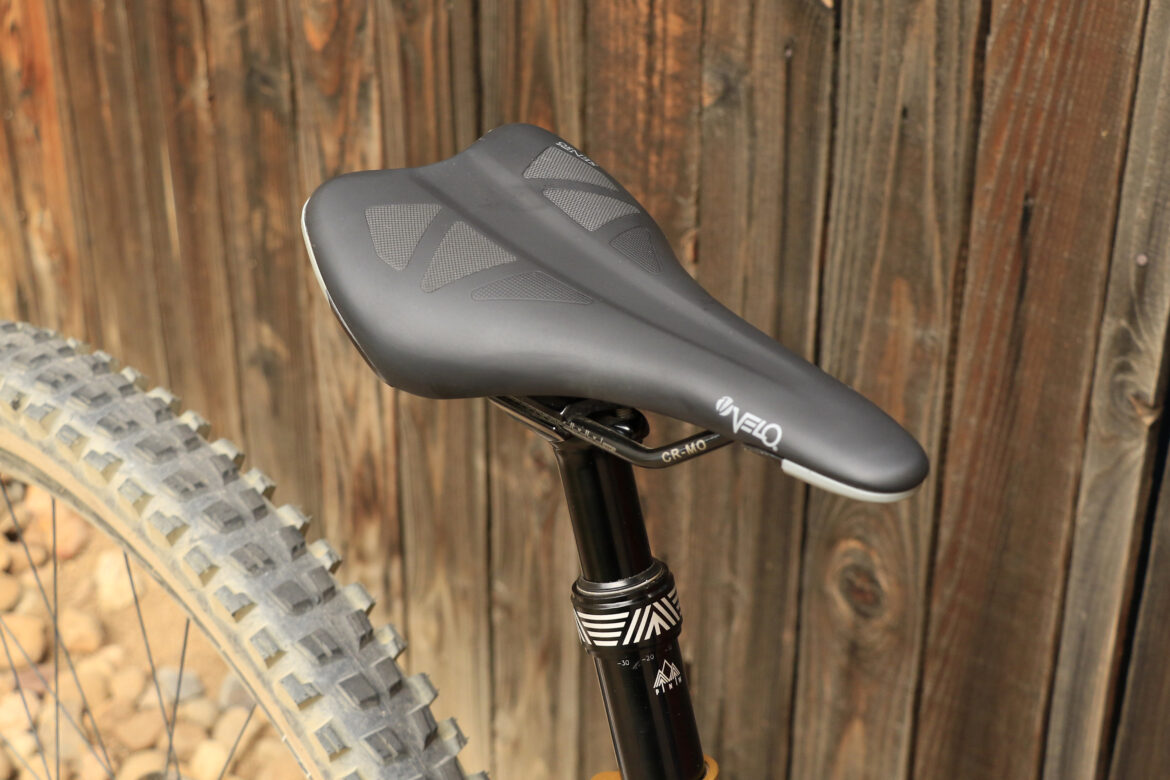
Velo Senso Wilson
- Price: $65
- Weight: 227g
- Buy from Velo.
The Senso Wilson is Velo’s first-ever, dedicated mountain bike saddle. The saddle measures 242mm in length and 135mm in width. There are no other options for size and this one uses chromoly rails. Velo designed this saddle with inspiration from roadies and TT riders that would saw the nose off their saddles for less soft tissue pressure when the riders were in an aero position, and slowly, it’s caught on.


Velo suggests that riders set the rear of this saddle to align with where they’d run a saddle normally, rather than trying to accommodate for the shorter width.
The Senso Wilson’s narrow width and stubby length might not work for everyone, but it feels like it does what it says it’s supposed to do. The Wilson keeps padding minimal for a firm feel and is designed with a flat profile, although not quite as plank-like as some of the other saddles featured. The back of the saddle is also designed to open up clearance for bigger tires.
It feels like the saddle has some flex to it, like the Velo Angel Fly we tested last year, allowing it to conform to the rider’s sit bones. The shorter nose does seem to work and we haven’t encountered any numbing with the saddle yet, even after long pedals. The shallow relief channel in the center likely helps with this. On the rear, textured rubber helps keep butts right where they’re supposed to stay.

WTB Silverado
- Weight: 204g (claimed for Silverado Medium Titanium)
- Price: From $48
- Buy from Planet Cyclery.
The WTB Silverado was refreshed in 2023 with changes to the width and length along with adjustments to distribute pressure more appropriately. Our take: the changes provided a notably positive riding experience. Plus, the new Fusion Form technology creates a supportive base with a sleeker look while enhancing comfort.
Read a complete review of the WTB Silverado saddle.

WTB Volt Comp
- MSRP: $47.95
- Weight: 317g
- Buy from Jenson USA and other retailers.
A couple years ago we surveyed Singletracks readers and found the WTB Volt to be the most popular saddle. It’s fairly common to see this saddle specced on new mountain bikes so it’s no surprise many riders have experience with it. Not only is the Volt widely available, WTB offers the design in 5 different finishes and with seemingly endless color choices.
I put some time in on the Volt Comp recently piloting the Jamis Portal, and I have to say I am pleasantly surprised by the quality of this inexpensive saddle. It looks great, keeps quiet, and the neutral size and shape makes it a safe choice for most riders. The only downside to the comp version seems to be the 300g+ weight.
| Saddle | Weight | Price |
|---|---|---|
| Bike Yoke Sagma | 225g | $140 |
| Ergon SM Pro | 235g | $110 |
| Ergon SMC Women’s | 294g | $80 |
| Ergon SMC Core | 345g | $150 |
| Fabric Scoop Race Radius | 255g | $105 |
| Fi’zi:k Gravita Alpaca | 216g | $99 |
| Funn Adlib HD | 335g | $55 |
| SDG Bel-Air V3 | 236g | $89.99 |
| SDG Radar | 228g | $99.99 |
| Specialized Power Expert with Mirror | 218g | $200 |
| SQLab 612 Ergowave | 164.5g | $199.99 |
| Velo Angel Revo | 280.7g | $125 |
| Velo Senso Wilson | 227g | $65 |
| WTB Silverado | 204g | $143 |
| WTB Volt Comp | 317g | $39.95 |
How to choose a mountain bike saddle
Finding the right saddle for mountain biking is crucial. As one of the three main contact points on a bike, a bad saddle has the potential to ruin even the most excellent mountain bike ride. Today I’m going to talk about the things to look for when choosing a mountain bike saddle including the construction, materials, sizing, and features that make for a great saddle.
A bike saddle has four main parts.
Starting at the bottom, the rails are where the saddle is attached to the seatpost. These can be made from various materials including aluminum, titanium, and even carbon fiber. There are some performance benefits like improved damping for various materials and designs, but generally more expensive titanium and carbon rails are simply lighter weight.
Next is the shell. This is basically a thin sheet of plastic or other semi-rigid material that gives the saddle much of its shape.
On top of the shell there is generally a layer of padding. Gel, foam, or other materials can be used for padding. Race-oriented saddles typically have minimal or even no padding to save on weight, while recreational saddles are sometimes marketed as offering “extra” padding. New riders shouldn’t assume that more padding in the form of a gel seat cover, will make an uncomfortable saddle more comfortable. As we’ll see later, finding a saddle with the proper size and shape is more important.
Finally, MTB saddles have an outer layer wrapping the shell and padding called the cover. The cover is the most visible part of the saddle and should be able to withstand abrasion. Many saddles use synthetic materials, though it’s also possible to find real leather saddles on the market.

While mountain bike saddles all have a similar shape — narrow at the front or “nose,” and wider at the back — there are many different widths and lengths to choose from. The width dimension on a saddle is measured at the widest point of the saddle. Choose the width of the saddle based on the width your istial (phoenetic) tuberosity or, sit bones. The sit bones are basically the spots where most of your body weight rests in a sitting position. This explains how to measure your sit bone width. 145mm seems to be a good medium starting width for mountain bikers, with narrower and wider options available from most brands.
In terms of length, longer saddles are generally better for climbing, while shorter saddles tend to do well for more aggressive handling. Among the most popular saddles for mountain bikers, the average length falls around 276mm. Womens saddles are generally shorter, with an average around 260mm.
Most saddle shapes generally include either a channel or a cutout in the middle of the saddle to improve circulation. Again, focus on finding a saddle that has support for your sit bones to ensure maximum comfort. Also, note that many saddles on the market today are not mountain bike specific, which means you don’t need to worry about whether a saddle is made for the road or the trail. Some manufacturers like Specialized market saddle specifically designed for off road use.
Prices for bike saddles can vary pretty widely, with budget models starting at $35 and high end saddles going for $300 or more. It’s possible to get an excellent saddle for mountain biking for about $100, and that saddle should last the lifetime of your bike.
If you want to geek out and learn even more about mountain saddles from an expert, be sure to listen to our podcast interview with WTB saddle category manager Sean Madsen. Or, learn about bike saddle angles and positioning and how to set your seat height properly.












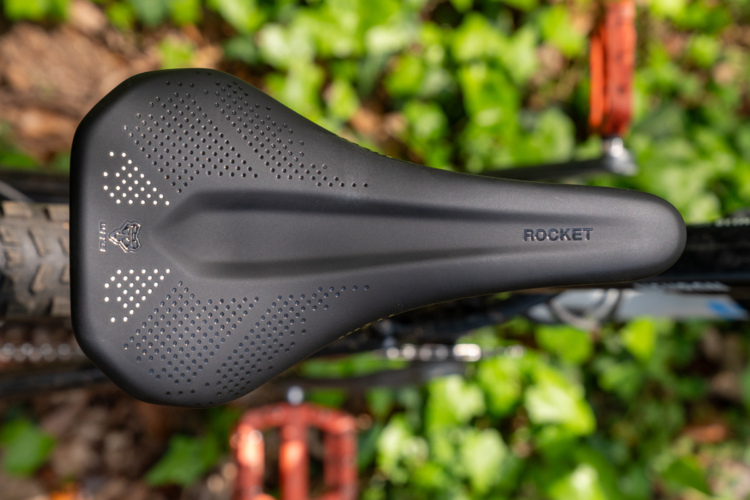

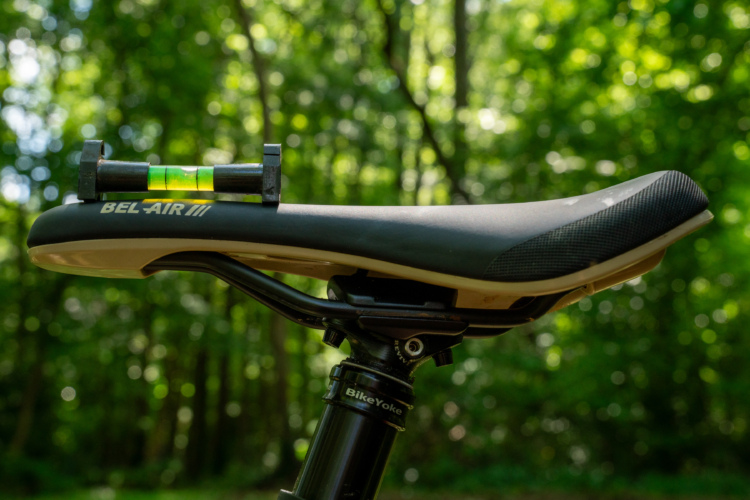
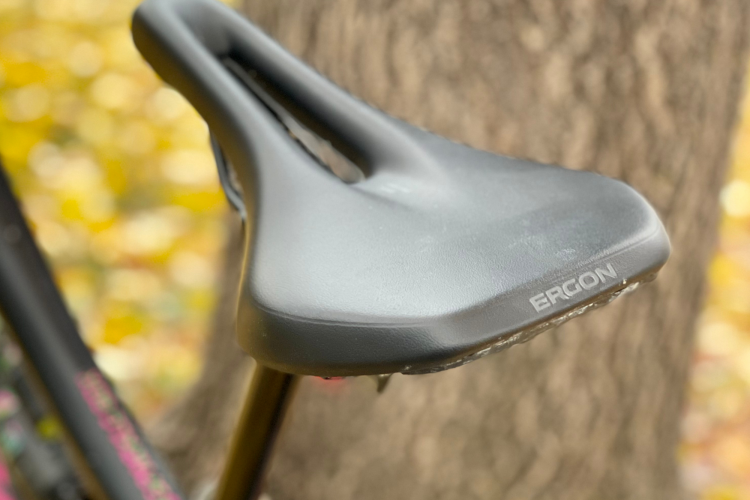
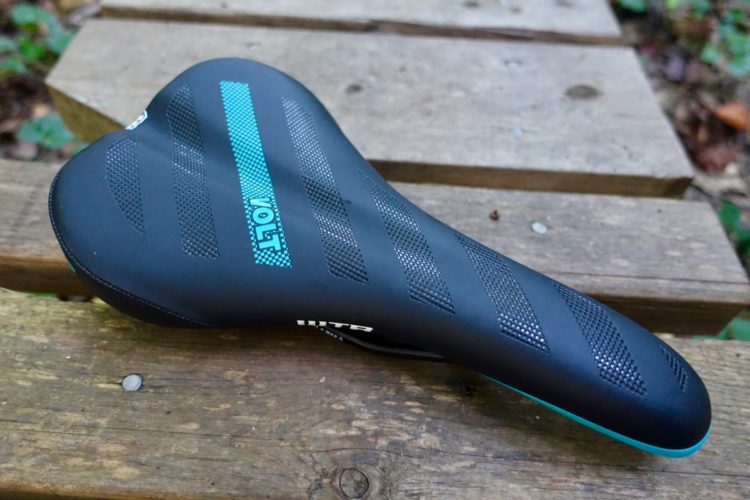

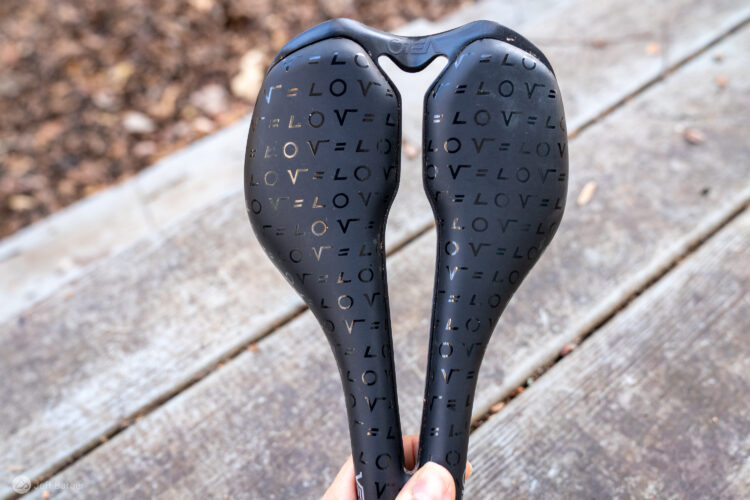
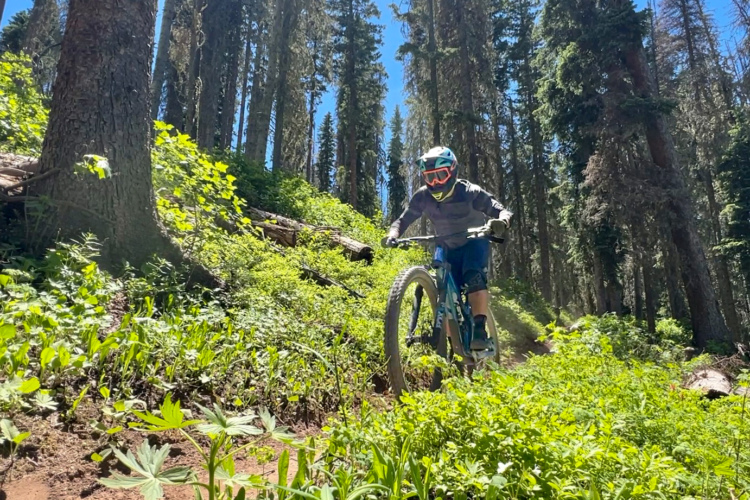




4 Comments
Sep 29, 2020
Mar 5, 2024
Oct 6, 2024
Oct 7, 2024